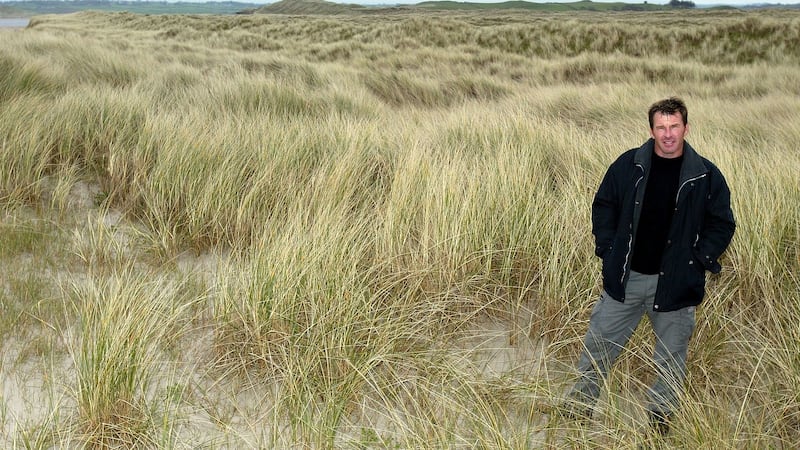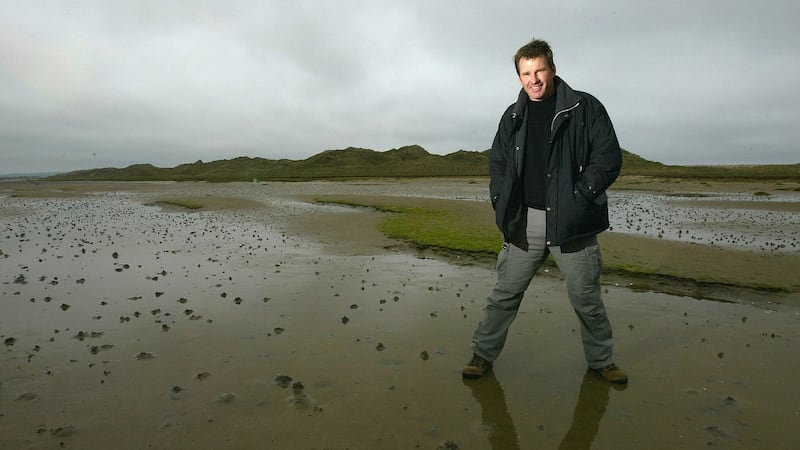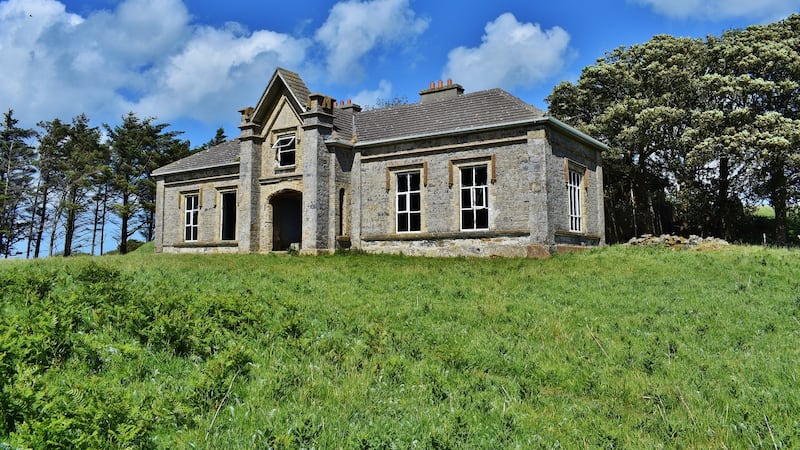When Nick Faldo revealed that he was planning to build one of the world's best golf courses on an island off Mayo, there was widespread anticipation in an area craving the investment. Two decades later, the former world number one is still waiting for his dream course to take shape.
After the excitement of early years, talk of a world-class course for the West has died down. Of course that’s not to say Faldo’s own dreams have waned. There is talk of the project resurfacing and there is talk of the island being sold, but the true story of Bartragh Island’s destiny lies, to an extent, unexplored.
Despite the swirling rumours and whispers that have accumulated over the course of a generation Faldo has remained relatively tight-lipped on his plans for the island, with only the odd public reference to this mysterious stretch of land.
So, what exactly is happening?
Will the dream become reality?
Or will the island remain untouched?
Will Bartragh Ireland ever open up to the world?
**********
From his vantage point overlooking the bay Nick Faldo stood speechless and unexpectedly enthralled, the architectural plans circulating in his head as he fixed his gaze upon the land down below. He had travelled the world, conquered courses from Muirfield to Augusta to Mount Juliet and Killarney, assumed he had seen and had done it all. But the sight of a long narrow island between west Sligo and north Mayo had placed a hypnotic spell upon the man, then recognised as one of the best golfers in the world.
And so for the guts of three hours he stood in awe and wonder and utter bemusement, inhaling the cool salty breeze of the North Atlantic drift, surveying the potential of a blank canvas before him: how had this Killala Bay jewel remained hidden and untouched? Thus began a lifelong ambition, one that would consume his attention for nearly two-and-a-half decades and one that would leave idle chatter to spread, extending through townlands like a fire through gorse.
The burning hope for development may have been reduced to an ember, but the man with the snuffer is unwilling to let go, or so it would appear – even if his campaign has been subdued through the years.
He eventually returned to the island last summer, this time with a production crew in tow. It brought hope and piqued interest. Faldo led Skratch TV, the in-house PGA channel, around the 420-acre island with all the boundless energy of a child whirring through the aisles of a toy store at Christmas. That the island had seductively drawn in the multiple Major winner became abundantly obvious from the very first seconds of the six-and-a-half minute film.
“There she is,” he gushed as his helicopter began its descent. “A true outback links.”
Scanning his surroundings from the ground, reminding himself of how it first lured him in, he continues in much the same awestruck tone, dumbfounded by the barren beauty of this west of Ireland gem: “As you can see, for golfers and golf nuts, the potential is frightening.”
But there’s an island to explore. So, with little intention of just standing around and shooting the breeze, he takes off in pursuit of future fairways and holes. As he wanders across clustered sand dunes, with authoritative strides through the thick marram grass, the cogs in his mind are evidently turning, imagination in full flow and creativity abound. He visualises tee-boxes and bunkers and his own personal cottage.
Then, a pertinent moment arrives. He happens upon a large hollow that sinks deep into the terrain. He beams. For he has discovered a final instalment in a rather nightmarish trinity – the Hell and Road Hole bunkers of St Andrews now have company in the form of a hazard at Bartragh.
“Imagine sand all the way around, even half of it would be nasty,” he says. “It must be 30-feet deep. That is some hazard.”
The gleeful expressions with which he speaks aren’t those of a man satisfied to walk away from this lifelong pursuit.
The excitement is tangible. Uncensored.
He’s under the spell and he cannot escape.
“Here we are at the seventh tee at Bartragh Island: This is one small step for man; one giant leap for golf architecture.”
He then swings back his iron, follows through as he strikes the ball clean and studies its trajectory as it hurtles down a fairway only he can envisage.
“Middle of the green,” he cheers.
“Christened – the first shot played at Bartragh.”
**********

For all the fervour on show, the island returned to the market a few months later. It remains on the market today.
"I still believe it will happen," says Mel Flanagan, the venerable Irish course designer responsible for first bringing Bartragh to Faldo's attention.
Though the lines of contact with Faldo have quietened through the years, Flanagan was an integral member of an exploratory team that endeavoured to develop a facility of worldwide acclaim.
He first wrote to the Englishman regarding the potential sale of the island after the previous owner, Seán Simon, approached him in the 1990s with the original idea. Flanagan didn’t expect a reply from a man still in the midst of a professional career, and even when he unexpectedly accepted an invitation to visit he brought with him a sense of subtly-disguised apathy. That changed from the moment Bartragh came into view, a few miles along the banks of the estuary outside Ballina, the veneer of silence replaced by sudden disbelief. Flanagan was there to experience it all.
“He knew every inch of the island and hand-on-heart he would move every inch of the island to bring it forward,” he says. “He did everything to get it brought forward. But if we were doing it again we would have approached it a different way.”
Plans were slow getting off the ground. There was plenty of speculation beforehand but it wasn’t until 2003 when the hearsay became a genuine possibility.
“Nick Faldo to turn Mayo island into golf haven,” declared a front page headline in the Western People that November. For most of the local paper’s readership this wasn’t news, but it was confirmation. The denizens of north Mayo had heard all the stories. The growing economy was gripping the nation and they craved some of the pie, some of the luxury, some of the excesses that had become a permanent fixture of the wider society
Just as whispers of Faldo’s interest began surfacing in 1997, the Asahi synthetic fibre plant on the outskirts of Killala closed with the loss of 315 jobs. Moreover, the Bellacorick power station, the main employer in the northwest of the county, was heading towards decommissioning shortly after the announcement. Bartragh was the area’s best chance of rebirth.
Nevertheless, at the same time, there was an understanding that a project of this magnitude, on a site boasting such indigenous beauty, would need to be carried out without being in any way invasive.
“There’s all this theory design which has ruined golf really,” explains Flanagan. “Every golf course should have 10 par-fours, four par-threes, four par-fives, the ninth should come back to the clubhouse – all this kind of baloney.
“With Bartragh you couldn’t do that because it’s so narrow. The ninth hole would be down at the very bottom end of the island and then the other holes would come back to the area where they built the old house. It wouldn’t follow any formula – the site would dictate it.
“You could build the Nicklaus way and impose a design on a site, or the Palmer way where you get a design and you put it down – that’s a lot of bulldozer work. The other way is where you find the holes that are embedded in the site. You move nothing – literally.”
**********

In that sense, Bartragh could have been a flagship for the country’s valuable links industry, an undervalued sector when considering its appeal to the global market, especially in the United States.
Over 200,000 golf tourists, according to Fáilte Ireland, arrive in Ireland to play golf annually, with half of those coming from across the Atlantic. And it can be assumed that the majority of those tourists come to experience golf on links courses, most of which are dotted along the brutally exposed coasts of Ireland and Scotland. The commercial golf course has its place in the tourism sector, but there are few countries in the world that provide the ideal conditions by the cliffs and the beach. Ireland brings that appeal.
“It can be done without any abuse of the site. It’s not destructive at all. Ireland would be playing to its strength then because it’s strength is its natural ruggedness and beauty.”
That such an approach wasn’t going to appease all concerned became almost immediately evident, the Western People noting – less than a month after Faldo appeared on their front page – that “the plans for the Killala Bay island were painstakingly positive to all but the foxes running wild on the dunes”.
“I remember when we posted that video on our Facebook page,” says Anne-Marie Flynn from Mayo North Promotions Office, referencing the aforementioned production. “We didn’t get a massive reaction at the time. What we did get was a lot of people saying we don’t need that kind of development here, that we should be trying to preserve this area as a nature reserve.
“We don’t need bulldozers coming in, big money and corporatism being ploughed into it. It was that kind of sentiment. And there’s definitely an argument to be made there because Bartragh Island is quite unique.”
That being said, Flynn still feels a balance can be struck for the betterment of an area in the same state of neglect as it was pre-boom.
“There is absolutely no doubt that it would attract interest and the kind of customer that spends money. So, it’s trying to find the balance there between a sustainable and environmentally sound development versus commercialism. Because there’s no point in saying otherwise – this area lacks tourism product.
“To have something like that here would absolutely economically change things.”
**********

The ambition was always to “handcraft” the course onto the island anyway, finding the holes rather than constructing them, meaning industrial machinery would be largely surplus to requirements. Subsequent developments exhibiting Faldo’s nous for golf architecture at Ballyliffin and Lough Erne, both of which boast indigenous and subtle designs which blend into their environments, proved those hoping to develop the island were true to their word.
But even their word wasn’t going to be enough for those vehemently opposed to any development at all.
A spokesperson for An Taisce stated that the country was “already well served in terms of coastal links courses” in response to the campaign, just as momentum was beginning to build. Whether such a statement stands up to scrutiny is clearly open to debate. Some statistics may suggest Ireland to have a wealth of links courses. Those statistics don’t lie. However, many of those facilities tend to be concentrated in hot spots, most notably along the Antrim and Kerry coast, and though the west of Ireland boasts impressive courses such as Enniscrone and Carne Links in Belmellut, that the province as a whole has yet to host an Irish Open is existential proof of its untapped potential.
Bartragh can only be reached by foot by a tombolo that becomes visible as the tide goes out, yet despite this inaccessibility there was never a desire to construct a bridge, or anything for that matter that could take away from the natural qualities.
Instead, amphibious vehicles capable of travelling across land and sea were touted as both a practical and achievable solution.
“In a golf course, there’s a thing called a psychological escape,” explains Flanagan. “You leave your troubles and your work and everything else behind. There’s the idea that there should be a bridge going into every golf club so when you cross the bridge you leave your troubles on the other side.
“So the idea at Bartragh was: when you got over there, it was a little principality of its own. You were completely away from the old rushing world and all that kind of stuff. It had everything you could imagine going for it.”
But the ecological argument, as vocal as it was, was not the sole aspect of opposition to the plans.
Attempts to restore Bartragh House, located on the east side of the island, had been taken by a previous owner but, in the time since, the house has been reduced to ruins once again.
How a dilapidated residence – constructed in the 1830s by Charles Kirkwood, a midshipman during the Battle of Trafalgar – would be incorporated into a world-class golf resort, along with any frills that came with it, became yet another obstacle for the development to overcome.
Among those who feel that the house must be of primary concern in any development in the future is David Hicks, the author of publications delving into the history of Irish country houses like Bartragh. But, as a local resident, Bartragh holds a certain allure.
“I’m probably a realist in that I know the history or the beauty of the location is not going to bring people to Bartragh Island,” he says. “It’s a necessary evil – and that’s probably the wrong word to use.”
“I would see it in terms of pounds, shillings and pence. There is no way the restoration of the house, the walled garden or the original out-building or even the development around those can happen unless there’s something to attract tourists.”
Not only is there a need to sensitively restore Kirkwood’s residence, he adds, the island also needs to retain the public amenities that are currently in place.
**********
Today, the beaches along the island are frequently visited by locals where barbeques and picnics are a common occurrence. Even local fishermen and visitors to the area take advantage of the bountiful supplies of trout in the bay, using the shallow waters around the island to drop anchor for lunch. It’s assumed to be public property and any diversion from that would likely cause a swell of dissatisfaction among a cohort of locals.
“That would be a huge loss,” says Hicks. “If you go down by the quay in Ballina, there are a lot of people with boats and it’s a big thing to go up and down with boats to Bartragh Island.”
But the appetite is certainly there. While Flynn suggests that “there’s not an awful lot of chat about it at all”, she also adds, “there’s definitely some enthusiasm for it, there’s no doubt about that”.
“There have been so many false dawns with Bartragh Island,” continues Hicks.
“Even if they said tomorrow that somebody has it bought and they’re going to spend millions on it and they’re going to do X, Y and Z, I think we would all say, ‘Sure we’ll wait until we see it’.”
It’s easy to understand such a pessimistic outlook. Some members of the consortium that bought the island with Faldo have died while a dispute between two previous owners in relation to a buy-back arrangement made it all the way to the High Court in the last decade.
These circumstances suggest a sale may struggle to go through, though the very same can be said for a development taking shape.
“With the help of God it might come again,” says Flanagan, also a member of the consortium. “I did my best – and I know that I would get money out of it – but I always thought it would be a great thing for that area. It would really lift it.
“Faldo didn’t decide by accident that this was the best place in the world. He has travelled the world. He was the number one golfer in the world around that time. It was an informed decision of his that it would be in the top three golf courses in the world if it was built. It would be up there with the best of the best of the best.”
There have been no reports of another Faldo appearance since his appearance last summer.
Was the flying visit merely a flirt with a dream of the past?
Or was it more?
His silence, most likely, means he’s weighing up the possibilities: to consign history to the past or to strive for his paradise.
“The tragedy of it is it would have brought about 300 jobs into Mayo,” maintains Flanagan. “If Ireland is going to survive long-term, it has to make use of the beautiful sites. There’s nowhere in the world like the Sligo-Mayo coast, and Galway.
“It’s ironic but if there is a downturn in the economy, people will have to look sensibly at these projects that are there.”
There’s as much mystery surrounding the island now as at any point since the 90s.
There’s a sizable chunk of appetite evident on most sides of the story.
There’s undoubted potential in a place that could give north Mayo recognition around the golf world and beyond.
Will it happen?
Is there a chance?
The ultimate truth is: Only Faldo knows.
*The Irish Times reached out to Nick Faldo but he was unavailable for comment at the time of publication.





















